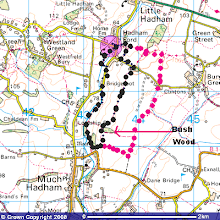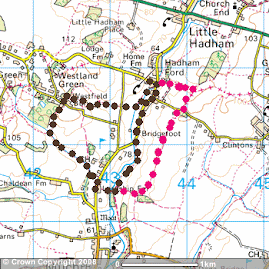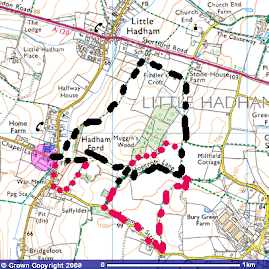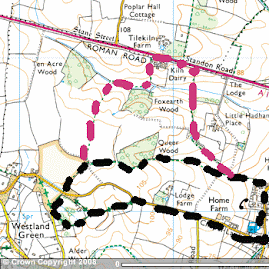Day 1:
Tuesday morning found me arising at the unearthly hour of 3a.m., ready for the drive to Luton airport for a 6.20 flight to Nimes. All went well, arriving in Nimes at 9.20 local time where I caught the airport bus to the city centre. From here, time for a coffee and beer before the 11.20 bus to Arles some 40 minutes away. As luck would have it, I got straight on to the Saintes Maries de la Mer bus at Arles and was in the capital of The Camargue by 12.30. Once checked into my hotel room, changed into clothes more appropriate to 30C, I was off for the first of many wanders. This was my 6th Camargue visit in 10 years, a place I always thoroughly enjoy being in for birds, animals, insects, food, wine and scenery.
The afternoon saw me wandering along the road out of Saintes Maries in a north easterly direction to Cacherel and Pioch Badet. Either side of the road are lagoons and mudflats. However, heavy rain early on the Tuesday had filled these. There was more water than I wanted to see, but this meant gulls and terns rather than waders were to be seen. Within 400 yards of leaving the town: greater flamingo, gull billed, whiskered, sandwich and common tern, black headed gull, hobby, house sparrow and starling had been registered. Overhead, high, several unidentifiable raptors, probably black kites. A side track on to mud gave views of summer plumaged dunlin, several curlew sandpipers, plenty of avocet and little ringed plovers. In the tamarisk trees as I approached Cacherel, some 4km from town, melodious warblers and plenty of sardinian and fan tailed warblers. Little egrets and grey herons everywhere with cattle egrets in with the horse and bull fields. A quick check around the cattle gave views of yellow wagtails, too.
I wandered on up the road, taking time to check fields and the huge expanse of sky adding more common birds as I went. One aim was to find the correct settings for the camera as, with a bright sun and clear blue sky, over exposure was a regular problem. Certainly gulls, terns and egrets were tricky as their white plumage reflected so much light. A few practice shots here to start off with. Photos shown here are my seconds as I keep the "best" ones for my talks as some of the groups I give presentations to advertise this site and it wouldn't be fair for people to turn up for a talk already having seen many of the photos.
 |
| greater flamingoes from the road from Saintes Maries de la Mer. Heat haze an issue. |
 |
| Scarlet darter: seen everywhere in their 1000's! |
 |
| Pony treks: regular activity |
 |
| Little egret |
 |
| little tern |
 |
| grey heron |
 |
| house sparrow. |
All these shots were taken trying to accommodate different light and shades of the birds as well as having the camera fast enough to freeze any flight shots. Not too successful with the little tern and better with the egret.
I headed back to town and, after a doze, went out for an evening meal and a few cognacs with a pleasant Irish couple I met in the restaurant. It had been a long day and the following day promised to be equally tiring, if not quite so long.
Day 2:
A change of plan as the weather looked like it could turn damp and I didn't want to be caught out, miles from cover if a thunder storm broke. I got caught in one of these back in 2007 and it nearly wrecked my camera. So, off for a walk along Le Digue which follows the beaches of the town, past a large campsite and out on to endless mudflats and salt marsh. Unfortunately, after about 3 miles of good birding, the mosquitoes were becoming unbearable and were finding places that I hadn't sprayed with repellent. I was standing next to lots of brackish water, so what did I expect! By now I had registered crested lark, more waders including a party of 150 avocet, 250 dunlin and curlew sandpipers as well as more of what I had observed yesterday. It became very overcast with a few raindrops, but nothing more. It was clear that most of the summer breeding birds such as bee eater and hoopoe had already moved south, but still plenty to see. A red kite lazed overhead and in the distance, slender billed gulls could be picked out amongst many black headed gulls by there apparently darker bill and longer neck when feeding. An elegant gull, but too far for a worthwhile shot. Huge flock of starlings were checked for anything else, but nothing as little egrets constantly called and argued. Eventually, the mosquitoes got the better of me, so back I went, noting several common sandpipers and a turnstone on the beach with 2 ringed plover. Back at my room, I applied a huge amount of Jungle Formula and headed off to get the 11.05 bus to Pont du Gau and the Parc Ornithologique, a bus ride of 15 minutes.
I first checked the many lagoons along the side of the road and, as usual, a few remaining black winged stilts and wood sandpipers before I paid to get into the parc. This is a good spot and, once beyond the caged birds found injured in the area and rehabilitated here, mainly raptors, you enter a 4 mile route around a scrape with many hides and viewing screens. At first, it looked deserted, but after a while, birds became apparent.
 |
| white stork study |
 |
| yellow legged gull |
 |
| grey heron wading at the Parc Ornithologique |
 |
| Legs! |
 |
| cattle egret |
 |
| Last flamingo photo!! Perhaps! |
 |
| cattle egret with skulking night heron |
 |
| Camargue horses are everywhere |
 |
| white stork and roosting flamingoes |
 |
| View across the very full scrape. |
 |
| Another photogenic little egret. One of 100's noted. |
Over the bridge and around the scrape gave views of many birds, to begin with, rather distant. A kingfisher fly past and 2 spoonbills whilst a pied flycatcher and melodious warbler were in the tamarisk. One of the spoonbills was ringed and these details have been emailed to the ringing group at the Parc. Last year I sent off details of a white stork that had a large ring; it had been ringed as a nestling in The Camargue the previous year. A little further along, both praying mantis and clouded yellow butterfly were seen, the former being a first for me, a creature I didn't know was to be found here. Fascinating to watch with its superb camouflage. Also along here, scarlet darters in their hundreds and a few black tailed skimmers roosting on the warm stones.
As I approached the end of the scrape, where there are a few viewing screens, a black kite and common buzzard floated over and black tailed godwits could be heard. In the distance, a fair few waders just outside the 2 main hides. On the path, a splendid green lizard gave good photo opportunities and a coypu disappeared off the path and into the reeds. Little terns were feeding juveniles on a mud flat and from the first main hide, a group of spotted redshanks and some avocets, before I moved on to the main, 2 storey hide. Here, I spent a good 2 hours as waders kept appearing from behind islands and out of the tall vegetation; well worth the wait. In the time I recorded: common, green and marsh sandpiper, spotted redshank, black tailed godwits, little ringed plover, little, whiskered and gull billed tern, avocets, shoveler and mallard. Time well spent.
After this, I headed back to the cafe in the main area where a coffee was enjoyed with views of herons and egrets and a couple of red crested pochard. The bus was on time, giving me a chance to try a local speciality before boarding, a Camargue rice beer. Very refreshing after the wander of several miles in temperatures now over 30C. The warmest time of the whole trip.
 |
| Skipper sp, possibly small skipper? |
 |
| winter plumaged spotted redshank |
 |
| same bird |
 |
| Praying mantis, a new creature for me. |
 |
| Clouded yellow |
 |
| black tailed skimmer |
 |
| spoonbills, including ringed one |
 |
| another scarlet darter |
Back in Saintes Maries de la Mer I took a quick wander around the west side of the town, where there are several lagoons: coots, purple and grey heron, a short toed eagle over and plenty of mallards. This was close to my room, so I planned on returning at first light. In a canal a family of coypu fed on bread that had been thrown in for the large carp that frequently surfaced. Out to another local restaurant for some excellent food and wine before a final beer back at the hotel. Thursday promised to be another long day, with plenty of walking, so not too late to bed.
More photos from the Parc Ornithologique here.
 |
| swimming spotted redshank |
 |
| greenshank |
 |
| avocet |
 |
| black tailed godwit |
 |
| 2 black tailed godwit |
 |
| mallards, black headed gull, black winged stilt (juvenile) 2 spotted redshank |
 |
| size comparison: spotted redshank and black winged stilt |
 |
| gull billed, little and whiskered terns |
 |
| greenshank |
 |
| marsh sandpiper and 2 little ringed plover (one yellow flagged) |
 |
| terns and mallards |
 |
| 3 spotted redshank, little ringed plover and common sandpiper |
 |
| 4 spotted redshank, little ringed plover, common sandpiper |
 |
| greenshank |
 |
| greenshank and spotted redshank |
 |
| green sandpiper |
 |
| marsh sandpiper |
 |
| mallard and marsh sandpiper |
 |
| common sandpiper |
 |
| green lizard |
 |
| coypu |
Day 3:
I started with a first light check on the westerly lagoons and pleased I did, as an osprey was fishing on the far side, too distant for a photo. Another short toed eagle over and constant swallow and martin movement south west. In amongst these swarms were red rumped swallows and good numbers of crag martins. Latter difficult to get on with the binoculars but their white breast and no brown band, along with dark underwing coverts and obvious lighter marks on the tail. Then, again, a plan that changed due to the recent weather. I took the bus to Paty de la Trinitie where I know a good path that winds through cattle and rice fields. Had much birding success along here on previous visits. However, after a couple of miles, the track was so flooded from rain it became virtually impassable and this, plus very few notable birds, meant I headed back to the village. Huge numbers of starlings around the farm, yellow wagtails in the fields and several raptor species over (sparrowhawk, lesser kestrels (3) and both red and black kite) plus a few darting spectacled and fan tailed warblers in the tall bamboo like reeds, but very little else. Again, I was lucky and a bus arrived just as I put my tripod and kit down at the bus stop and back to town and another walk out of the town to the east. More of the same, with more turnstones noted on the beach, but I had decided to leave the scope and camera back at the hotel and just enjoy a binocular walk, taking time to look for insects. Plenty found as well as more birds, with good numbers of warblers and pied flycatchers. I wandered over the mudflats between the Cacherel road and Le Digue footpath, coming across a black redstart, egrets, herons and a flyover group of glossy ibis. A party of 5 black winged stilt flew over also and there were always waders to look for. Constantly seeing birds was excellent as more clouded yellows flew by. I was continually noting vagrant and lesser emperor dragonflies in their 100's and darter species in their 1000's. The place was alive with them. On the road, many dead ones having been struck by cars and cyclists. Small dragonflies, probably demoiselle species, Calopteryx virgo meridionalis and Calopteryx haemorrhoidalis. Also, a tiny, black damselfly.
The bird list was now over 70 for the trip. I finished the day with a quick walk out of town in a northerly direction to check roadside lagoons but just regular waders with the more common raptors overhead. I did disturb a roosting black kite, which, had it not flown off, would have been a good photo opportunity. So back into town and another meal before my final day and one that I needed to have a reasonable night's sleep for!
 |
| cattle egret |
 |
| Synchronised feeding |
 |
| ringed plover |
 |
| popular tree |
 |
| avocet flypast |
 |
| Notre Dame, Saintes Maries de la Mer. Used as a reference point by sailors. |
 |
| Fisherman at dawn |
 |
| yellow wagtail |
 |
| business end of greater flamingo |
 |
| Little egret fishing along Le Digue |
 |
| lesser emperor |
 |
| turnstone |
Day 4:
Up at first light for a quick check around the local lagoons before the cycle rental shop opened. Passport handed over along with 15 euros and I cycled as far as the bus stop and put the bike in the boot of the bus for a drive to Albaron, some 20km north. Here I alighted and headed east with La Capeliere my planned destination, some 21 km away. The last time I had been on a bike was here last year and I am sure I vowed never to rent a bike again. However, the road is flat and I saw some great birds that I would have missed had I rented a car. There is no public transport along this road. A stop at a bridge gave views of kingfisher, cattle, little and great egrets in fields. These were also being quartered by gull billed terns. A little further along at Mas Neuf there is a look out tower but not too much noted: glossy ibis over, black kite, 20 short toed eagles heading south, more g b terns, 1st of 3 rollers,! Great place. I carried on, trying to get close to 2 more rollers but to no avail. Fan tailed and cetti's warbler calls accompanied me all along this road to Villeneuve where there is a bar. Beer time, I was parched. I saw in the distance a circling of raptors, all common buzzards. From here, I headed south down the eastern side of Etang de Vaccares, stopping to check the large lake which held 100's of great crested grebes, whilst gadwall, mallard, egrets and a few flyover stilts were also noted in various lagoons. At one stop, just before the reserve at La Capeliere I chatted with a bird watching English couple whom I bumped into again on the reserve. There are good hides at this site and having paid the few Euros entry I was out on the 2 - 3 km trail. From one hide another overhead short toed eagle, whilst at another, common sandpiper and kingfisher. In the trees a skulking juvenile night heron, pied flycatchers and a selection of already seen warblers. A water rail called but was not seen. After the trees the track takes you on to a heath type habitat where both kestrel and a hobby flew off as I appeared. Another melodious warbler near the reed bed hide and 1000's of dragonflies (and mosquitoes!) The butterflies here consisted of the continental form of speckled wood, a stunning swallowtail, several red admiral, clouded yellow and, as yet, an unidentified species, which appeared quite common.
Edit: now identified as Great banded grayling, thanks Graeme. A great place for a wander and from the lookout vantage points you can scan the large Etang. Flamingoes shimmered in the heat haze and several early arriving black necked grebes were noted in with the great crested ones. By the end of autumn this lake will be holding 10,000's of coot and all manner of wildfowl, including pochards and grebes.
I bought a small guide to French dragonflies and got back on the bike. Back to the bar a matter of 5km away before the 16km from there to Albaron. Black kite, peregrine, glossy ibis were all noted as I cycled along, as was a drifting montagu's harrier in fields to the north. By the time I had stopped the bike it was gone. However, the highlight was 2 collared pratincoles flying low right in front of me, a bird I still haven't got a photo of.
I got to the bus stop a few minutes after the bus had gone, so nothing to do but visit an old haunt, L'Agachon bar in Albaron for coffee and Leffe before the bus came and I was back in Saintes Maries by 7.15. Worn out and ready for a shower and meal. Been a really good day. Finished with another steak and wine with coffee and cognac, paid my bill and said farewells before setting the alarm for 5.30 ready to catch the early bus to Arles to make the trip for the 10.20 plane back to Luton.
 |
| sand martins resting on shutter: Saintes Maries de la Mer |
 |
| yet another scarlet darter |
 |
| distant and uncooperative juvenile roller |
 |
| Swallowtail butterfly at La Capeliere. Stunning! |
 |
| Speckled wood |
 |
| very high soaring short toed eagle at La Caperliere |
 |
| Great banded grayling |
 |
| great egret from road near Villeneuve and La Capeliere |
 |
| willow warbler at La Capeliere |
Day 5:
The whole journey went well, but a word of warning for anyone flying from Nimes: presently no shops etc once you have gone through security, just uncomfortable wooden benches, so my advice is do not go through too early. I got there early, checked in my rucksack containing my tripod and headed off to an area round the side of the airport that usually holds good warblers, corn buntings and stonechats as well as snakes. Plenty of collared dove, a singing but unseen black redstart and 2 pied flycatchers seemed to be the only birds there. A check in trees where I had previously recorded scops owl drew a blank and just one snake scurrying away before I could get anything on it for id, so back to the airport and the 1 hour 35 minute flight home. Superb 3.5 days birding and several hundred photos to delete!!
My plan had been to get some new photos for my presentations, I have certainly achieved that with spotted redshank, greenshank and marsh sandpiper useful additions, plus several general views and improvements on birds I already include in the talks. All very worth while.
Species List:
black necked grebe, great crested grebe, cormorant, night heron, cattle egret, little egret, great egret, grey heron, purple heron, white stork, glossy ibis, flamingo, spoonbill, mute swan, mallard, gadwall, shoveler, teal, red crested pochard, osprey, short toed eagle, red kite, black kite, marsh harrier, montagu's harrier, common buzzard, sparrowhawk, kestrel, lesser kestrel, hobby, peregrine, water rail, moorhen, coot, avocet, black winged stilt, collared pratincole, little ringed plover, ringed plover, lapwing, turnstone, dunlin, curlew sandpiper,wood sandpiper, common sandpiper, greenshank, marsh sandpiper, black tailed godwit, black headed gull, slender billed gull, yellow legged gull, lesser black backed gull, little tern, sandwich tern, gull billed tern, common tern, whiskered tern, wood pigeon, collared dove, eagle owl, kingfisher, roller, great spotted woodpecker, skylark, crested lark, sand martin, crag martin, swallow, red rumped swallow, house martin, white wagtail, yellow wagtail, black redstart, blackbird, sardinian warbler, spectacled warbler, savi's warbler, cetti's warbler, melodious warbler, willow warbler, chiffchaff, pied flycatcher, house sparrow, chaffinch, great tit, magpie, jackdaw, carrion crow, starling, goldfinch.
90 species in total.



























































































































































